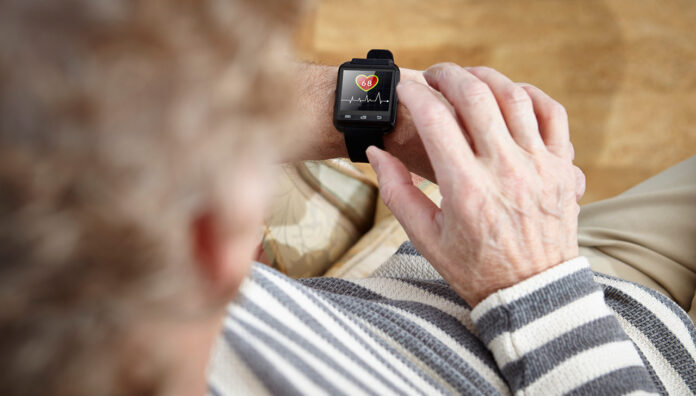An important aspect of chronic disease management is patients taking ownership of their own health – whether checking their weight or tracking physical activity, heart rate, or blood sugar levels.
Smartwatches, owned by around one in three Australians, can provide a handy, continuous, and integrable monitoring platform that greatly facilitates this process. But they are not without drawbacks.
Australian Pharmacist explores the pros, cons and potential uses of smartwatches in healthcare, and how pharmacists can best support patients to use them in chronic disease management.
There’s an app for that
There are numerous smartwatch apps on the market, which can track a variety of health metrics such as:
- step count
- heart rate
- sleep stage estimation
- peripheral oxygen saturation
- heart rate variability.
Some are even validated by the Therapeutic Goods Administration, including the AppleWatch electrocardiogram algorithm – which alerts users if an irregular heart rhythm (atrial fibrillation) is identified.
With smartwatches able to detect how quickly an individual moves, studies have been conducted into its use, fuelled by machine learning, for early detection of Parkinson’s disease.
These tracking and monitoring functions can facilitate the management of a variety of chronic diseases, including:
- diabetes
- hypertension
- cardiovascular disease
- respiratory conditions
- movement disorders.
Many chronic disease monitoring activities have traditionally been recorded on a humble piece of paper. But smartwatches are much better at capturing data, said Professor Sepehr Shakib, Professor of Clinical Pharmacology at the University of Adelaide’s Faculty of Health and Medical Sciences.

‘They’re then able to monitor that information and look at trends or changes over time,’ he said. ‘By having this data readily accessible, patients can then communicate it much more easily with healthcare professionals such as pharmacists.’
Synching with other devices
There are a variety of monitoring devices readily available at pharmacies that can be synchronised with smartwatches, said Prof Shakib, including:
- automated blood pressure machines
- continuous glucose monitors
- smart scales
- ovulation trackers.
With the average patient seeing their pharmacist far more often than their GP, they can facilitate patient self-monitoring with linked devices.
For example, a veteran with diabetes might see their pharmacist every 11 days to pick up medications or test strips.
‘If the patient is recording their health data, having clinician involvement every 11 days, including answering questions about monitoring or management, could be very powerful,’ said Prof Shakib.
When at-home devices are synchronised to smartwatches, pharmacists also have the opportunity to validate the accuracy of these devices.
‘They can then reinforce to the patient whether their device is accurate or not and provide reassurance around their [technique],’ he said.
Interpreting smartwatch data
Pharmacists have an important role in helping patients make sense of smartwatch data for chronic conditions. Take hypertension for example.
‘This type of condition lends itself well to self-management, because you can measure your blood pressure, upload the data to an app and track it,’ said Prof Shakib. ‘When you can tell your blood pressure is going up, you don’t have to wait 3–6 months to see your GP,’ he said.
But a key issue with blood pressure self-assessment is understanding variance.
‘Patients can feel stressed when their blood pressure goes up, and are falsely reassured when it comes back down,’ said Prof Shakib. ‘They may not inherently understand how labile and fluctuant blood pressure data is.’
This is where pharmacists can provide reassurance that it’s the average that counts.
With patients’ dispensing history at hand, they can also advise whether a check in with the GP is required, or if there is an issue with how they’re measuring their blood pressure.
Pharmacists can also suggest lifestyle and dietary tweaks when overall blood pressure is high.
‘Simple things such as cutting down salt and alcohol, and increasing physical activity can make a big difference,’ he said.
This doesn’t have to entail working out at the gym but fitting in more ‘exercise snacks’ throughout the day, such as increasing walking by parking further away from your workplace.
‘When reiterated by the pharmacist, and followed up with self-monitoring apps, this is a powerful way to improve behaviour,’ said Prof Shakib.
Interface difficulties
Smartwatch apps have user interfaces by IT experts who test their underlying tech functionality, said Prof Shakib.
‘For example, smartwatches have fall identifiers which might be useful for the elderly, so if a person suddenly falls, it can trigger an alert saying “it seems like you’ve fallen. Do you want to call 000?”,’ he said.
‘That requires intelligent [perception] of patterns of deceleration to detect a fall as opposed to someone kneeling on the ground.’
But the user interface is not always appropriate for people with poor health or tech literacy.
‘[Considering whether] the user interface is appropriate for the eyesight of the elderly, and the colours are appropriate for people who have cataracts doesn’t tend to capture people’s imagination as much as how good it looks and the fabulous things it might be able to do,’ said Prof Shakib.
Using multiple tracking apps and linking other devices to smartwatches also requires patients to be somewhat tech savvy.
‘Using apps instead of paper to record health data requires the patient to know how to use them and input the information the right way,’ Prof Shakib said.
This is where pharmacists need to have a clear understanding of the role they should fulfil.
‘If a patient presents with data, helping them make sense of it clinically is what pharmacists should be doing, for example if the patient asks, “I’ve been checking my blood glucose levels, I’m not sure what that means”,’’ he said.
‘But it shouldn’t be up to the pharmacist to show patients how to [sync] the device, enter the data and manipulate the app.’
Interoperability challenges
Despite being able to track numerous different markers for chronic disease, the flip side is the lack of interoperability between smartwatch apps.
While the Apple System’s health app allows other devices and apps to plug in and feed data through it, it’s difficult to factor in multimorbidity – at least at this stage.
‘For example, patients with diabetes might have their physical activity captured on one app, levels of anxiety on another, and blood sugar levels on a third,’ he said.
‘When measured in three separate systems, it’s not easy for the data to be pulled together to determine whether stress over an upcoming event, for example, is throwing everything off kilter.’
While smartwatches have wide-ranging health tracking capabilities, just how precise they are is also unclear.
‘A lot of them haven’t actually been properly validated, so there are questions around accuracy,’ said Prof Shakib.
Learn more about the role of smartwatches in health care at the Atrial fibrillation: can your watch save your life? session as PSA24, led by Professor Sepehr Shakib.



 Professor Margie Danchin[/caption]
Professor Margie Danchin[/caption]

 Dr Peter Tenni[/caption]
Dr Peter Tenni[/caption]
 How should we deprescribe gabapentinoids, according to the Maudsley Deprescribing Guidelines[/caption]
How should we deprescribe gabapentinoids, according to the Maudsley Deprescribing Guidelines[/caption]



 Pharmacists have always prescribed, but they have the potential to prescribe much more
Pharmacists have always prescribed, but they have the potential to prescribe much more




